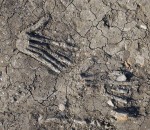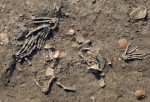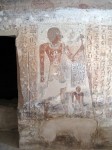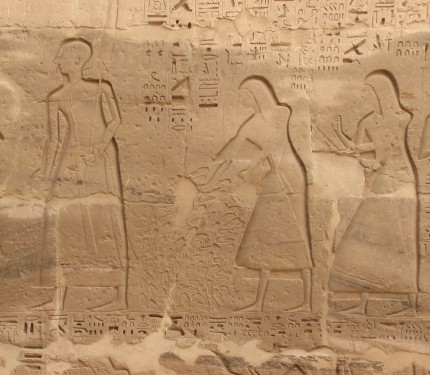 A team of archaeologists from the Austrian Archaeological Institute and the Austrian Academy of Sciences have found the skeletal remains of 16 right hands buried under an ancient palace in Tell el-Daba, Egypt. The hands are about 3,600 years old and date to when Canaanite Hyksos rulers controlled parts of Egypt. Modern day Tell el-Daba was known then as Avaris, and, strategically positioned on the Nile Delta, it was the capital of Hyksos Egypt. At the time the hands were buried, the Hyksos King Khayan ruled from the palace at Avaris.
A team of archaeologists from the Austrian Archaeological Institute and the Austrian Academy of Sciences have found the skeletal remains of 16 right hands buried under an ancient palace in Tell el-Daba, Egypt. The hands are about 3,600 years old and date to when Canaanite Hyksos rulers controlled parts of Egypt. Modern day Tell el-Daba was known then as Avaris, and, strategically positioned on the Nile Delta, it was the capital of Hyksos Egypt. At the time the hands were buried, the Hyksos King Khayan ruled from the palace at Avaris.
 Two of the pits were discovered in the forecourt of the palace. They had 14 hands between them. Two more pits with one hand each were discovered under a four-columned building that appears to have been an extension added to serve a ceremonial or religious purpose. The hands were likely buried for ritual reasons, as offerings to the gods.
Two of the pits were discovered in the forecourt of the palace. They had 14 hands between them. Two more pits with one hand each were discovered under a four-columned building that appears to have been an extension added to serve a ceremonial or religious purpose. The hands were likely buried for ritual reasons, as offerings to the gods.
 All of the hands are large and would have once been attached to soldiers. We don’t know if those soldiers were Egyptian or from elsewhere in the Levant, but we do know they were spoils of war. It’s a handy (GET IT?!) way to tally your kills. Warriors would remove the right hand from enemy soldiers they had killed and then present them to the king or representative official in exchange for “gold of valor.” In this case, once the severed hands were redeemed for gold, they were ritually buried.
All of the hands are large and would have once been attached to soldiers. We don’t know if those soldiers were Egyptian or from elsewhere in the Levant, but we do know they were spoils of war. It’s a handy (GET IT?!) way to tally your kills. Warriors would remove the right hand from enemy soldiers they had killed and then present them to the king or representative official in exchange for “gold of valor.” In this case, once the severed hands were redeemed for gold, they were ritually buried.
Cutting off the right hand of your enemy also had a symbolic and religious purpose: it removed a warrior’s strength, his means to wield a weapon, and left him defanged and crippled in the afterlife.
 This practice has been documented on tomb and temple reliefs, but this is the first time physical evidence of it has been discovered. Here’s a first person description of a warrior securing his gold of valor about 80 years after the hands were buried in Avaris. It’s a complete biography inscribed on the tomb of Ahmose, a soldier who fought under Pharaohs Ahmose I, Amenhotep I, and Thutmose I. Under Pharaoh Ahmose I, he fought against the Hyksos in the battle of Avaris and in the three-year siege of Sharuhen. Under later pharaohs, he fought against the Mitanni in Mesopotamia and rebellious Nubians in the Nile valley.
This practice has been documented on tomb and temple reliefs, but this is the first time physical evidence of it has been discovered. Here’s a first person description of a warrior securing his gold of valor about 80 years after the hands were buried in Avaris. It’s a complete biography inscribed on the tomb of Ahmose, a soldier who fought under Pharaohs Ahmose I, Amenhotep I, and Thutmose I. Under Pharaoh Ahmose I, he fought against the Hyksos in the battle of Avaris and in the three-year siege of Sharuhen. Under later pharaohs, he fought against the Mitanni in Mesopotamia and rebellious Nubians in the Nile valley.
Then there was fighting on the water in “P’a-djedku” of Avaris. I made a seizure and carried off a hand. When it was reported to the royal herald the gold of valour was given to me. Then they fought again in this place; I again made a seizure there and carried off a hand. Then I was given the gold of valour once again. […]
Then Sharuhen was besieged for three years. His majesty despoiled it and I brought spoil from it: two women and a hand. Then the gold of valour was given me, and my captives were given to me as slaves. […]
Now when his majesty had slain the nomads of Asia, he sailed south to Khent-hen-nefer, to destroy the Nubian Bowmen. His majesty made a great slaughter among them, and I brought spoil from there: two living men and three hands. Then I was rewarded with gold once again, and two female slaves were given to me.
The practice continued undeterred for centuries. Four hundred years after the Avaris hands were buried, massive reliefs on the outer pylons of Rameses III’s mortuary temple at Medinet Habu depict officials emptying out baskets full of severed hands to tally the dead in the Libyan War and then presenting them to Rameses.
It’s not clear from the historical record where this practice originated. It could have been introduced by the Hyksos, or the Hyksos could have picked it up in Egypt, or it could have been adopted from a third party.
